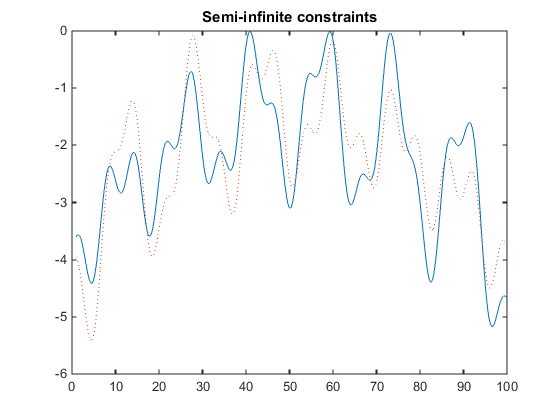一维半无限约束
找到最小化 x 的值
f(x) = (x1 – 0.5)2 + (x2– 0.5)2 + (x3– 0.5)2
其中
对于范围内的所有 w1 和 w2 值
1 ≤ w1 ≤ 100,
1 ≤ w2 ≤ 100。
请注意,半无限约束是一维的,即向量。由于约束必须采用 Ki(x,wi) ≤ 0 形式,因此您需要按如下方式计算约束
首先,编写一个计算目标函数的文件。
function f = myfun(x,s) % Objective function f = sum((x-0.5).^2);
其次,编写一个文件 mycon.m,计算非线性等式和不等式约束以及半无限约束。
function [c,ceq,K1,K2,s] = mycon(X,s) % Initial sampling interval if isnan(s(1,1)), s = [0.2 0; 0.2 0]; end % Sample set w1 = 1:s(1,1):100; w2 = 1:s(2,1):100; % Semi-infinite constraints K1 = sin(w1*X(1)).*cos(w1*X(2)) - 1/1000*(w1-50).^2 -... sin(w1*X(3))-X(3)-1; K2 = sin(w2*X(2)).*cos(w2*X(1)) - 1/1000*(w2-50).^2 -... sin(w2*X(3))-X(3)-1; % No finite nonlinear constraints c = []; ceq=[]; % Plot a graph of semi-infinite constraints plot(w1,K1,'-',w2,K2,':') title('Semi-infinite constraints') drawnow
然后,调用优化程序。
x0 = [0.5; 0.2; 0.3]; % Starting guess
[x,fval] = fseminf(@myfun,x0,2,@mycon);经过八次迭代后,解是
x
x =
0.6675
0.3012
0.4022解 x 处的函数值和半无限约束的最大值是
fval
fval =
0.0771
[c,ceq,K1,K2] = mycon(x,NaN); % Initial sampling interval
max(K1)ans = -0.0077
max(K2)
ans = -0.0812
生成了半无限约束的图。

该图显示了两个约束中的峰值如何位于约束边界上。
mycon.m 里面的 plot 命令减慢了计算速度。删除此行可以提高速度。